Think Madras or Chennai and the Marina Beach flashes in front of your eyes . The temples, the churches, the bridges and the buildings follow one after the other. And yet there is one sight that you do not wish to see. You switch off your senses the moment you walk past it so that you are immune to the stench and the dirt that surrounds it – the River Cooum, a dead river, a sewage dump that empties out into the Bay of Bengal.
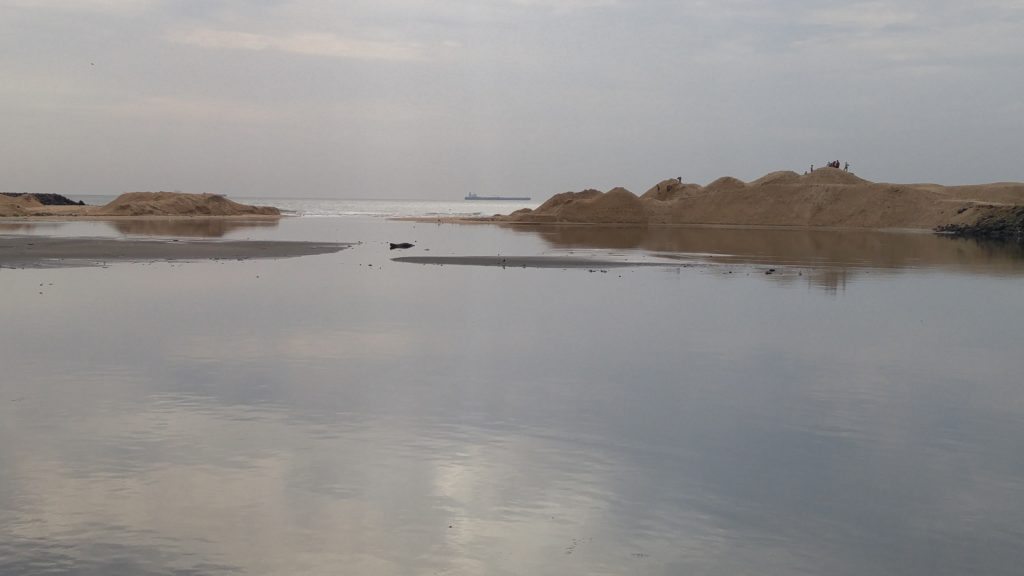
The estuary of Cooum and the Bay of Bengal
The river is as much a part of the city as the sea and yet many times I have wished as a child that it did not exist in the city . It was one tiny little blot for me, especially when I used to gloat over my city. as a proud Madras girl. In one of my essays on Madras which I had written in school and had won an award for it, I had quoted, with all due apologies to Lord Tennyson’s poem , ” The Brook”
“For men may come and men may go, but I (Cooum) stink on forever. ”
Years later, I had finally made my peace with the river. My parents had told me that it was once a picnic spot with boating facilities. I had hoped that it would be revived sometime.
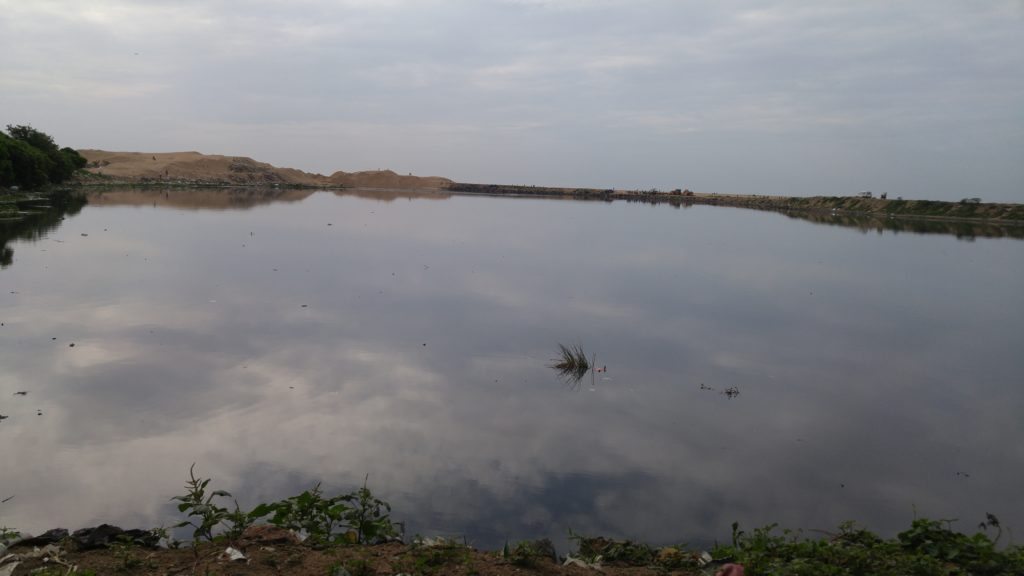
The River Cooum in Chennai
The River Cooum starts its life 70 kms before Chennai at Kesavaram where it splits from the parent, Kortalaiyar which empties into the sea at Ennore. Cooum enters the city near Poonamalee and its course of 32 kms in urban landscape remains polluted till date. Chennai has two more rivers, Adyar and Elambore or the North River , that is believed to have vanished from the maps, while the partially man made Buckingam canal runs perpendicular to these rivers.
Rivers have always fascinated me. They are the hot beds of civilisations. In their heydays they have seen many a battle fought and won. Their course may have been altered but several cities have sprung up and died on their banks. There is a sense of mystery when you see a river born as a tiny spring or a meandering stream while there is a sense of poignancy when it meets its end in the sea . I guessed the life of Cooum would have been no less grand. It would have seen better days . So when Venketesh Ramakrishnan, a historian and novelist along with his friends decided to research the history of Cooum, I was very keen on going on a trail along the banks.
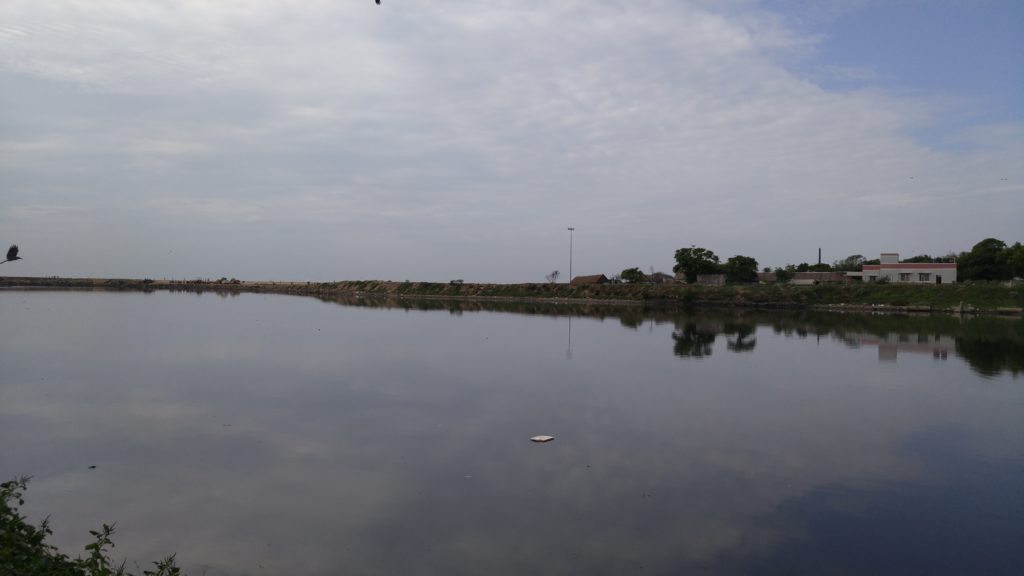
The river and the city
It was impossible to do one single trail along the river. There were historic trails – of four different battles that were fought on their banks, some more than 1000 years ago. There were mythological trails – of the numerous temples that were built , each of them telling its own story. There were architecture trails, trails that explored villages and localities that had sprung up along the banks of the rivers. There were rural trails, that go beyond the city to Takkolam and Pulallur where battles were fought . There were trails inside the city that takes you down the eons of history while exploring a melange of cultures . And there was the colonial trail – stories of the British India along these settlements linked to the river where they built buildings, temples, churches and several other monuments. So, on a grey Sunday morning, I went on an abridged version of the colonial trail along the Cooum with Venketesh who pointed out to some of the monuments that I had seen day in and day out and gave me a fresh perspective on them with his stories.
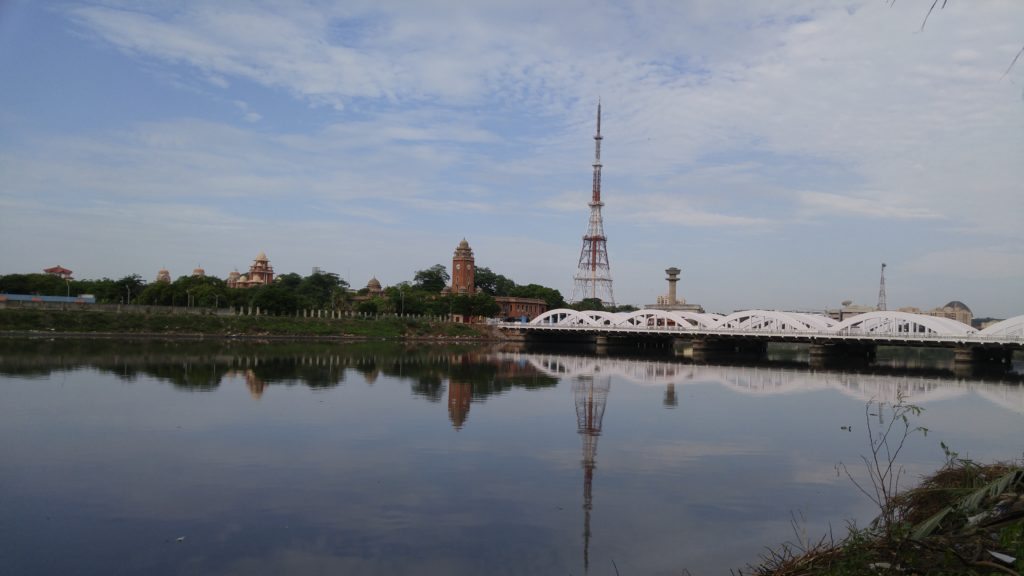
View of the landscape and monuments
This trail is not just monuments . Its about body guard deities and gods inside tree trunks. It is about a harem and a hamam of Nawabs which have morphed into buildings of Universities. It is about romantic hot spots that have become war memorials. It is about a landscape created by British – from a man made island to a beach , to monuments built by them – from forts to bridges. The Cooum has not just witnessed battles but also funerals that have entered Guinness World Records for record attendance. And thus our trail began.
The Estuary
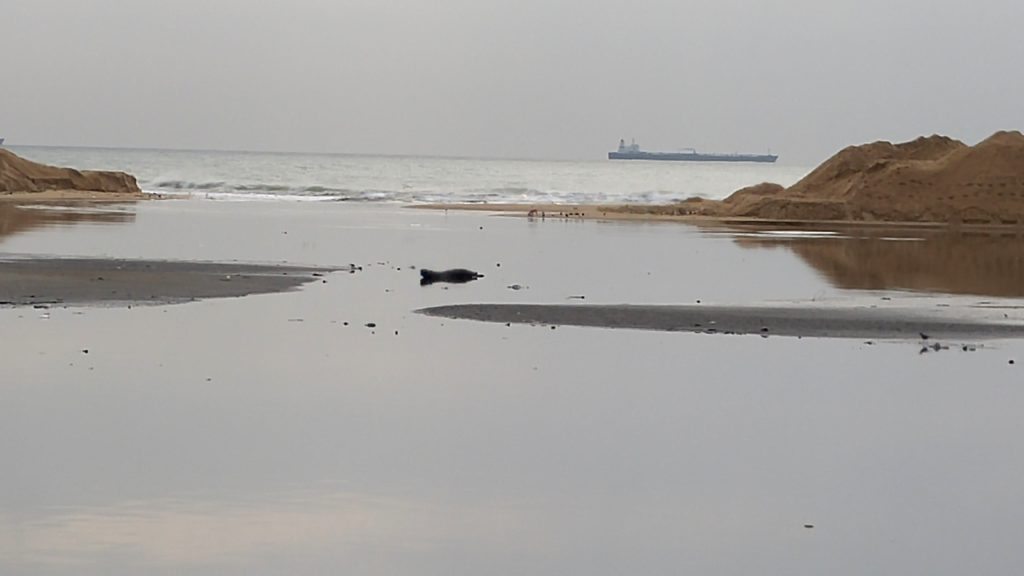
Estuary of the river and sea
We did not begin our trail at the source but at the end. Standing on the Napier Bridge built over the river, connecting Fort St George and Marina Beach, I looked down at the estuary – to where the river meets the sea. It was a cloudy day and the clouds were reflecting in the waters below. It seemed so hazy and all I could see were mounds of sands. Napier Bridge had always fascinated me . Built in the 19th century as an iron bridge, the new bridge today is over 130 metres long. There was no one around. The harbour stood in the distance. The walls of the sailing club still told the story of the German ship Emden which hit Madras during the World War 1.
We wanted to get a closer look at the estuary. Driving down Flagstaff Road – areas controlled by the army, we got a glimpse of the southern entry into Fort St George,as we headed to both the North and the South banks of the river. The South Bank was once the venue of one of the most historic funerals in the country. Venketesh said that more than 15 million people gathered here on February 3, 1969 for the funeral of the former Chief Minister of Tamil Nadu CN Annadurai, a number he added is in Guiness Recordsf for the “most attended” funeral. Marina Beach became Memorial beach with memorials for Anna and after him for MGR built here.
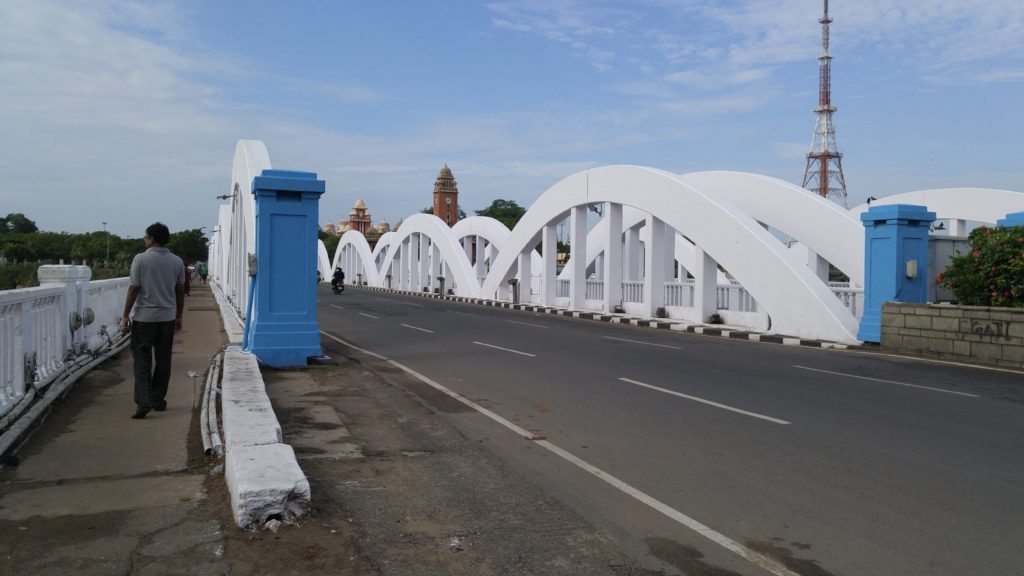
Napier Bridge that is built over the Cooum
Sri Devi Kadal Muthu Karumari Amman Temple.
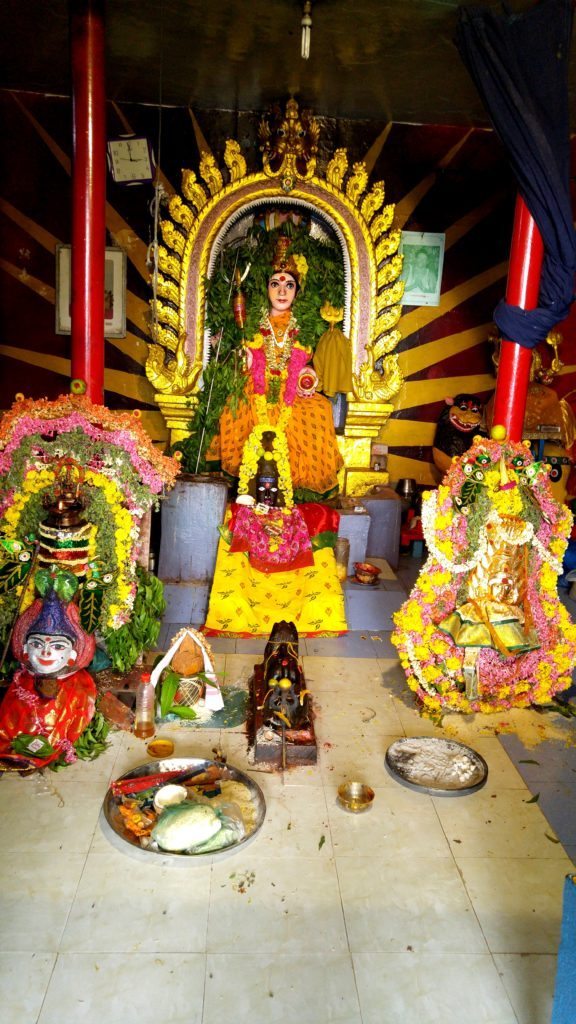
Goddess of the seas
Cooum has several temples built alongside its 72 kms course, probably 500 said Venketesh, but he took me to the last temple built on its banks before it meets its fate into the ocean. It was dedicated to the Goddess of the Sea. The fishing community were getting ready for a festival.
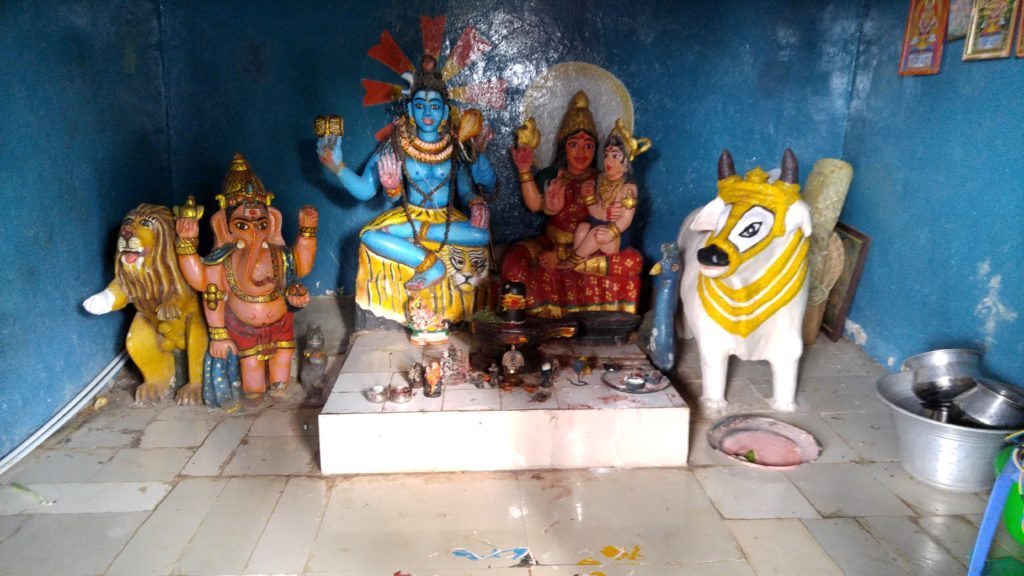
The last temple on the banks of the River Cooum
Besides the Goddess, there was a shrine dedicated to Shiva. I looked for a story but all I heard were loud drums as the festivities were about to begin. We stopped to see the view of the river . The Napier Bridge stood in the distance glittering in white as the water reflected the skies as people walked on the mounds of sand
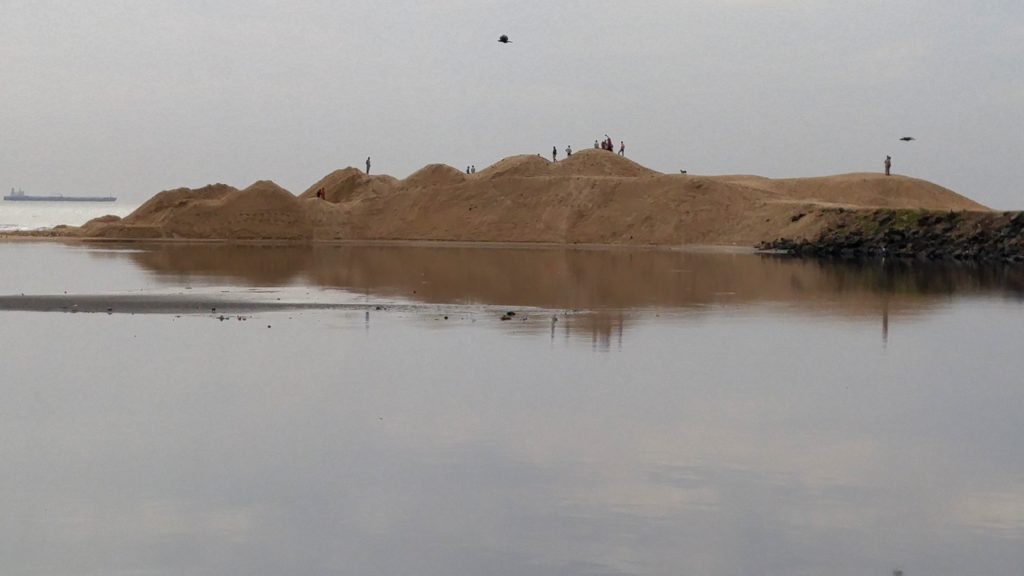
People like stick figures walking on mounds of sand
War Memorial
Right at the beginning of the Marina Beach is a circular structure built with rocks and marbles with a patch of greenery around . This was the War Memorial, first built to commemorate the victory of the allies in World War 1 and then the second . A memorial for the martyrs, the War Memorial pays homage to the lives lost in the Indo-China and Indo-Pakistan wars as well. It was believed that in the early days, a bellfry was housed here to warn about enemy intrusions.
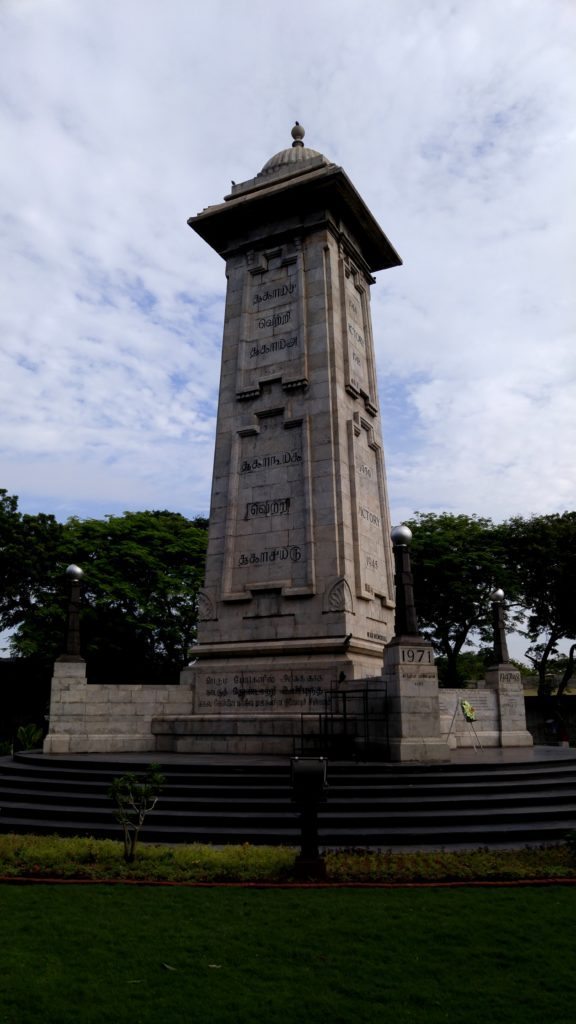
The War Memorial which was once a romantic spot
But picture this oasis of calm centuries ago, even before the structure was built. There was no Marina Beach, just the sea and at the further end was Santhome, a colony of the Portuguese. This promenade was then a romantic hot spot. Courtships, elopement and even scandals took place in this little area that it was nicknamed the Cupid’s Bow. As I took in this solemn silence, Venketesh told me that musical bands played here while the nearby Flagstaff Road took the name of Band Practise Road.
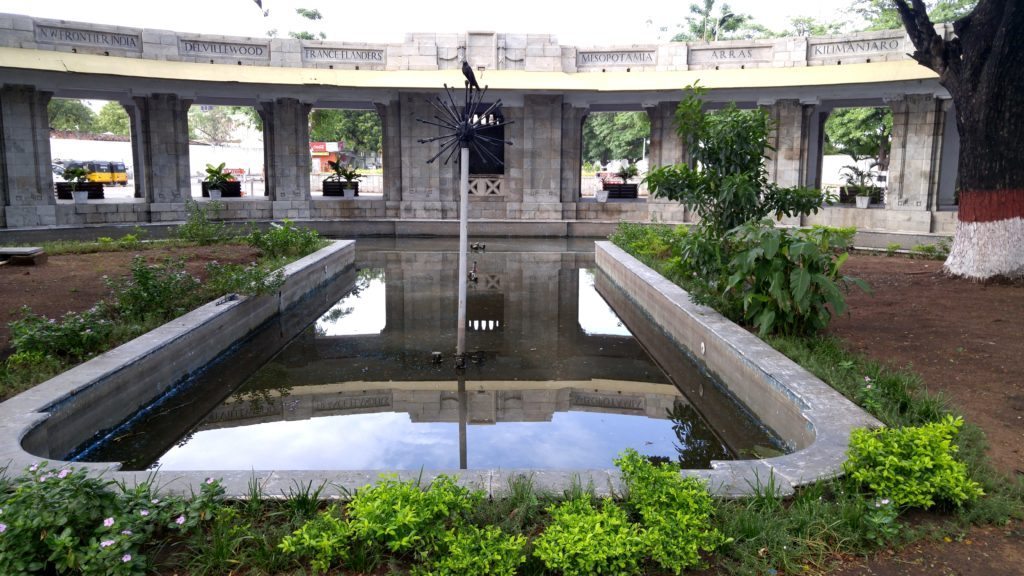
The war memorial in Chennai
The Island
The Island to me as a kid, always referred to the Island Grounds near the Madras Gymkhana Club which used to always host a fair, full of life and colour. It was later that I understood a bit about the geography of the city. The island was artificial created by the British who linked the rivers Cooum and Elambore. Standing opposite the club, I saw the towering statue of Lord Munroe, the man who Venkatesh says helped develop Mantralayam and even Tirupathi. The island is where the famous Mount Road, one of the arteries of the city, called as Anna Salai today originates. Stopping by a small cemetery, including one for the Armenians who lived here many years ago, we visited a small temple before continuing on our trail.
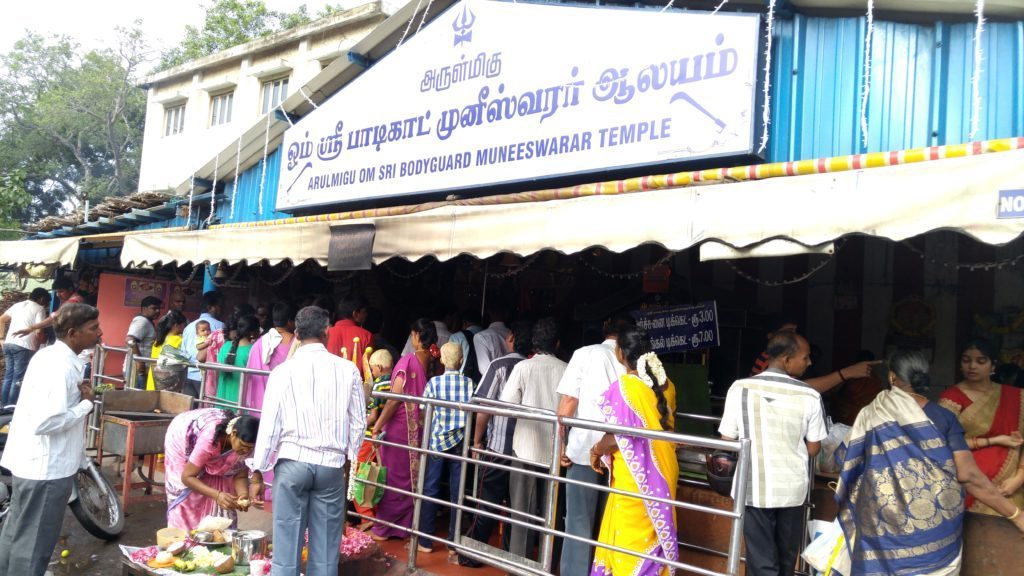
The Bodyguard temple in Chennai
Bodyguard Muneeshwaram temple
Along the pavement was a temple thronged by devotees. Women stood in rows preparing pongal on firewood for the deity.But what really intrigued me was the name – Bodyguard Muneeshwaran temple. The God here is the Bodyguard or probably, the Bodyguard is the God. It sounded too profound. I asked the women if there was a festival around. And they said that they dedicate pongal everyday to the deity.
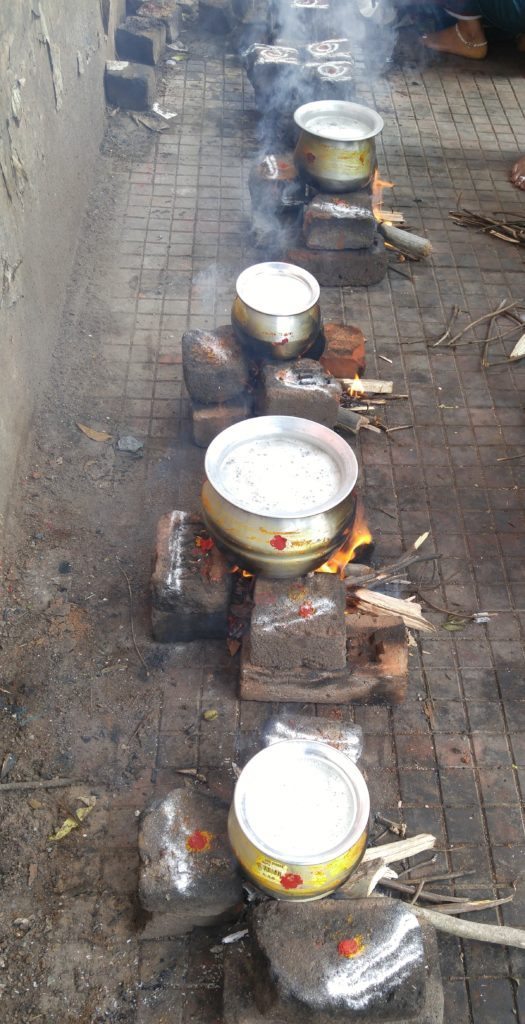
Pongal being prepared for the deity
That is when Venketesh told me the story. When the British ruled India, the bodyguards of the Governor had their own shrines – the Hindus worshipped here while the Muslim bodyguards had a mosque. But there is another tale too. Even today new autos and cars are brought here for worship before they hit the road. The story goes that the deity protects them from accidents, hence he is the bodyguard. It is believed that the deity, a form of Shiva was brought in here a century ago by some locals and was kept under a tree for worship. A British commander who objected to it apparently met with an accident on the same day. He had a change of mind which led to the locals believing that the deity would be their bodyguard on the road.
Chepauk Palace and Madras University
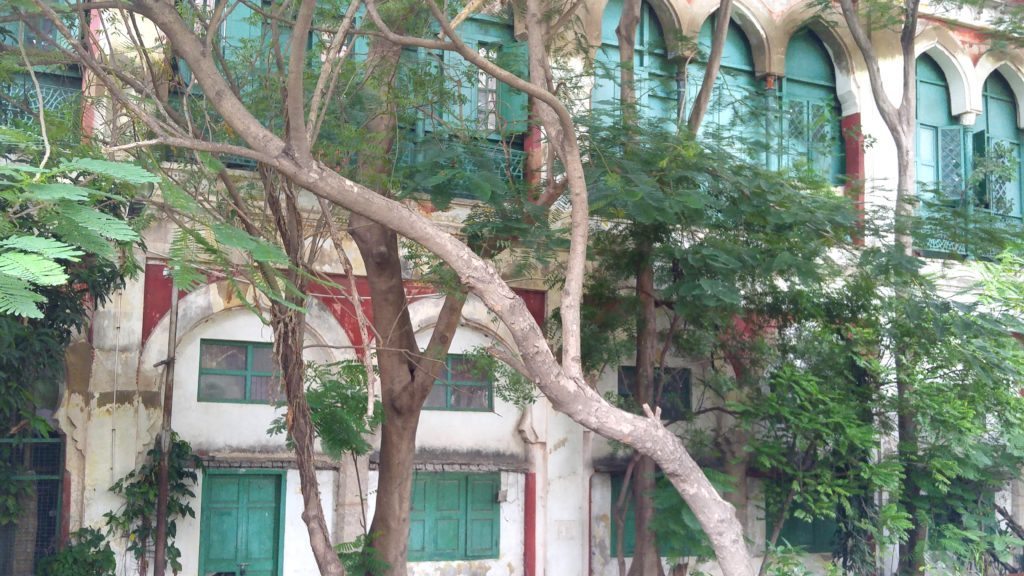
Shrouded by the trees – the erstwhile palace
Driving down Wallajah Road along Chepauk, we enter the Beach Road. Visitors to the city may know of Chepauk stadium, but not many know this was the Nawab of Arcot’s turf. The Chepauk Palace or whatever remains of it today can still be seen while even the gates of the stadium showcase some of the ornate art from the era. However, I will not embark on the Wallajah trail here – you can read it here – On the Wallajah Trail in Chennai
But there is a connection between the old ruins of the palace shrouded by trees and the gorgeous Indo Sarcenic Building – the Senate House in the premises of the Madras University. I have always wanted to study in this sprawling campus. But Venketesh interrupted my sighs and told me a very interesting snippet . The buildings were once part of the Nawab’s palace grounds and it housed among many things, a harem and a hamam as well.
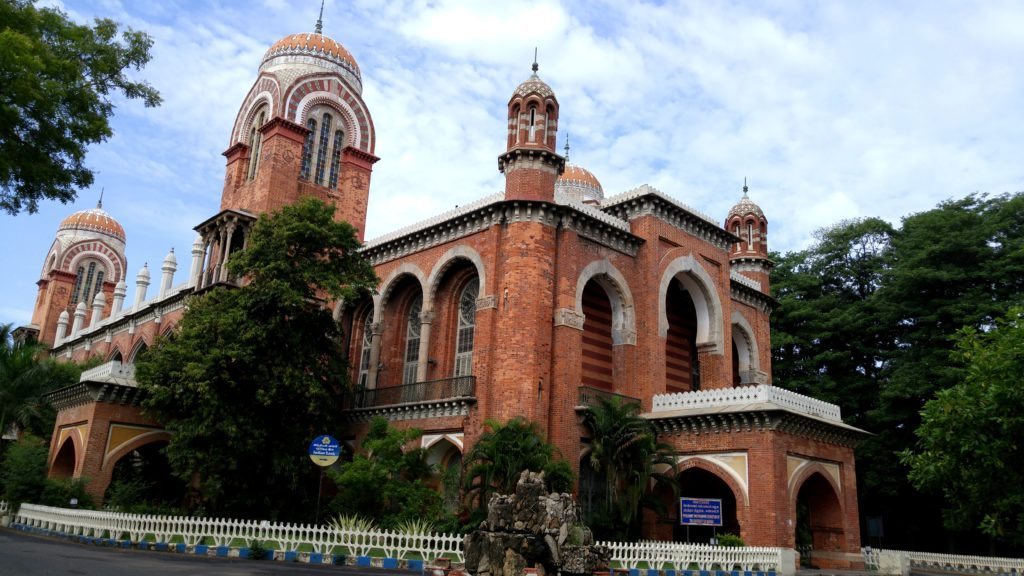
The Senate House of University
The British eventually bought over the land before building this Senate House, the library and the University . Standing here I could see tiny images of Nataraja and Ganesha among other Hindu pantheon of Gods carved in the pillars of the building. Venketesh added that among the many meetings and discussions that had taken place in the Senate House , one of the crucial decisions was by elected councillors to kill the River Cooum by damming it at source.
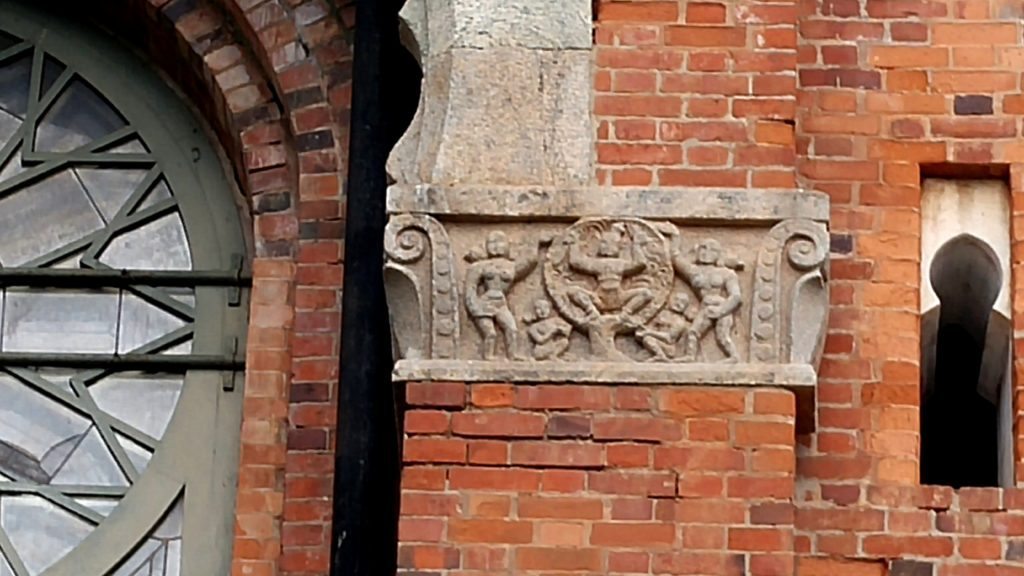
Gods in the facade of Senate Building
Trade on the Buckingham Canal
Along the way we stopped at the Buckingham Canal at the spot where it met the Cooum. This was once a trade route said Venketesh adding that salt from Marakkanam and rice from Nellore were brought in here through the boats. Even today we could see the navigation locks which used to allow boats to pass as the canal connected Kakinada to Villupuram.
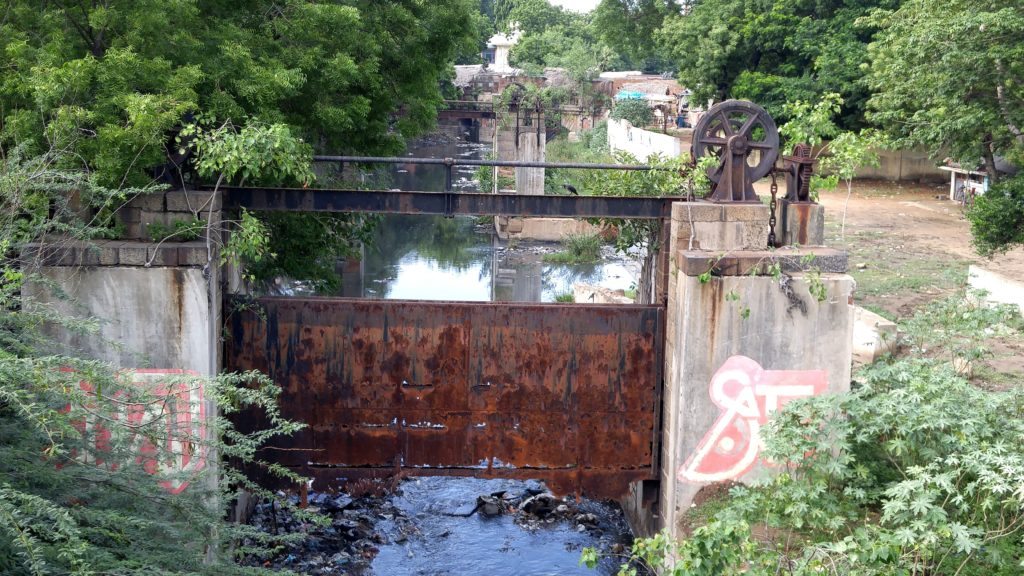
This is where the boats passed bringing in goodies for trade
Goverment Estate and Rajaji Hall
Much of the buildings in the Government Estate have been demolished to give way to a new building, which was earlier touted to be the Secretariat but is now a hospital. But one building remains here. Painted in pink, the famous steps of Rajaji Hall have featured in many a film but this was once the ballroom and the banquet hall of the British.
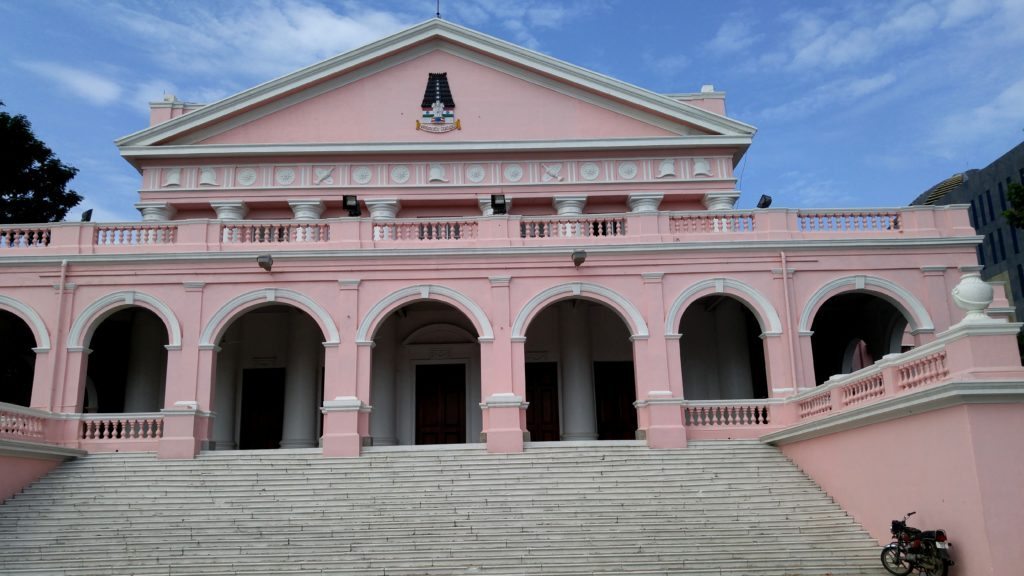
The Rajaji Hall which was the banquet hall
Temple in a tree trunk
A small board took me to a little shed near the out patient ward of the hospital where a Ganesha temple stands. The idol believed to have originated on its own grows between the trunks of a large tree that gives the shrine the feel of a sanctuary.
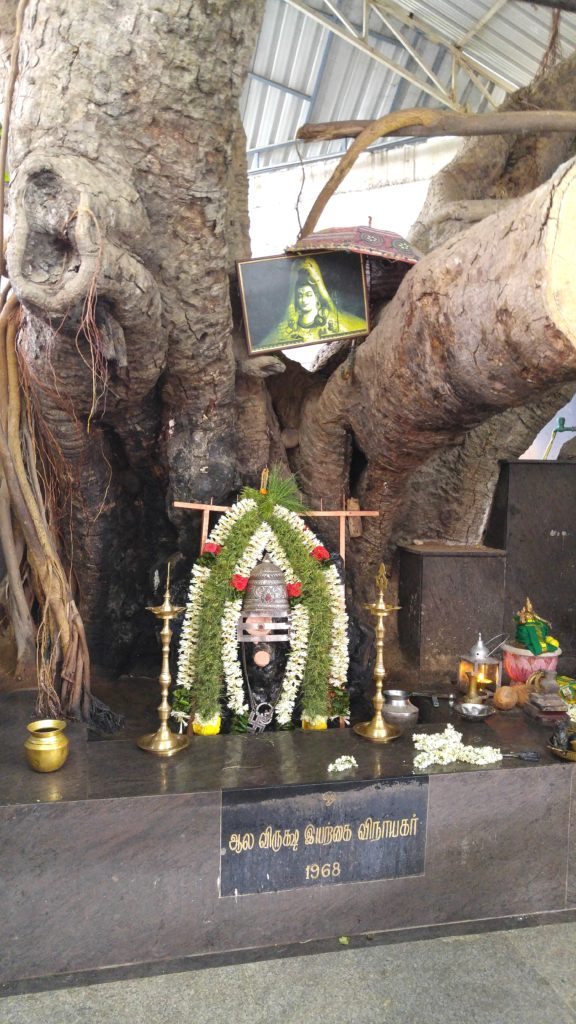
Ganesha in a tree trunk
Chintradripet
Our next halt was to Chintradripet, an area rich in history. The first thing that comes to my mind when you talk about Chintradripet is the fish market. One of the oldest said Venketesh adding that Chintradripet evolved essentially as a small weavers settlement. Chinna Thari Pettai became Chintadripet in the mid 19th century. Walk around and you can see so many old homes in these narrow lanes.
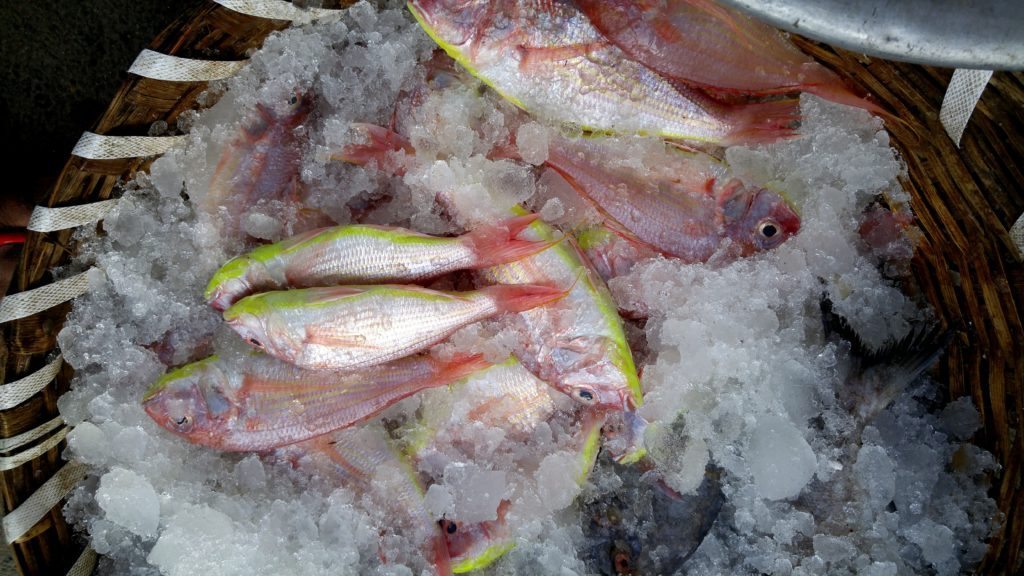
Fish market of Chintadripet
At the junction of Chintadripet and Mount Road is Simpsons, one of the oldest companies, now a part of the Amalgamation group. Venketesh said that they have been credited with the manufacturing of the first horse carriage, a bus, a car in India and even the engine of the first aeroplane that flew over Asia. Even the adjacent Napier Park is now called MayDay Park as it was the meeting place of the workers from Simpons, then the largest employer in the city. Venketesh added that the park was one of the first to be maintained by recycled drainage water. But there is so much history to this little area which is located on one of the banks of the Cooum. We stopped at a few monuments
Company Temples
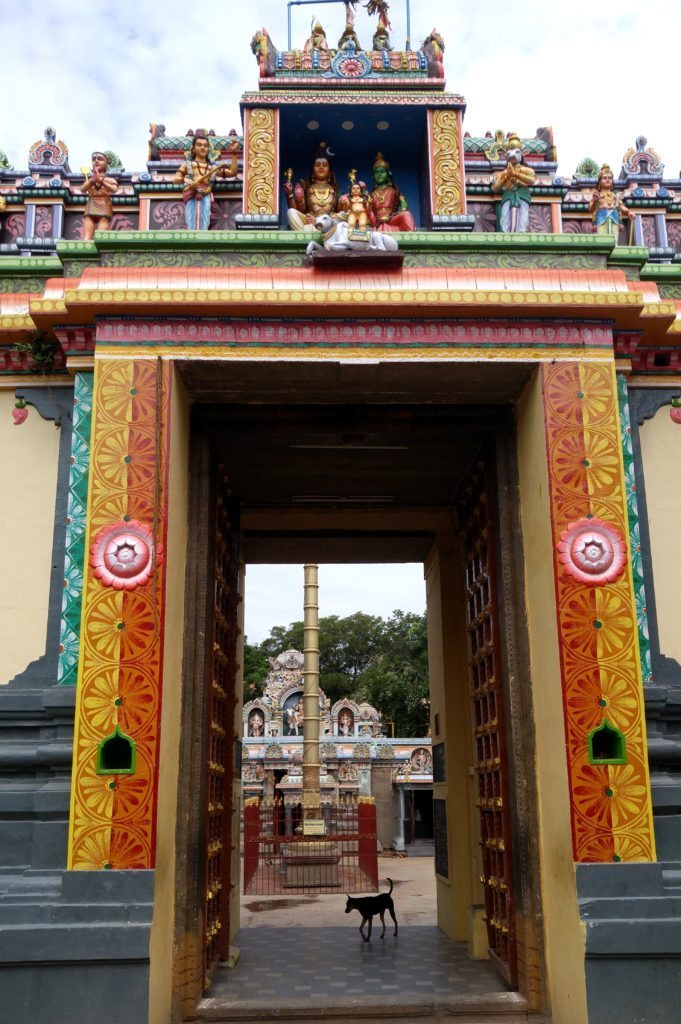
Entrance to one of the Company Temples
Twin temples dedicated to Vishnu and Shiva stand here today, a calm oasis in the busy streets, built almost 300 years ago . Sponsored by the British East India Company and built by the Dubashes, the men who were a liaison between the British and the locals and were so called because they knew two languages. These Dubashes were very powerful men and typically middle men, exploiting and enjoying the best of both worlds. Venketesh said that one of them was even a villain in a Walter Scott novel, but more on that later.
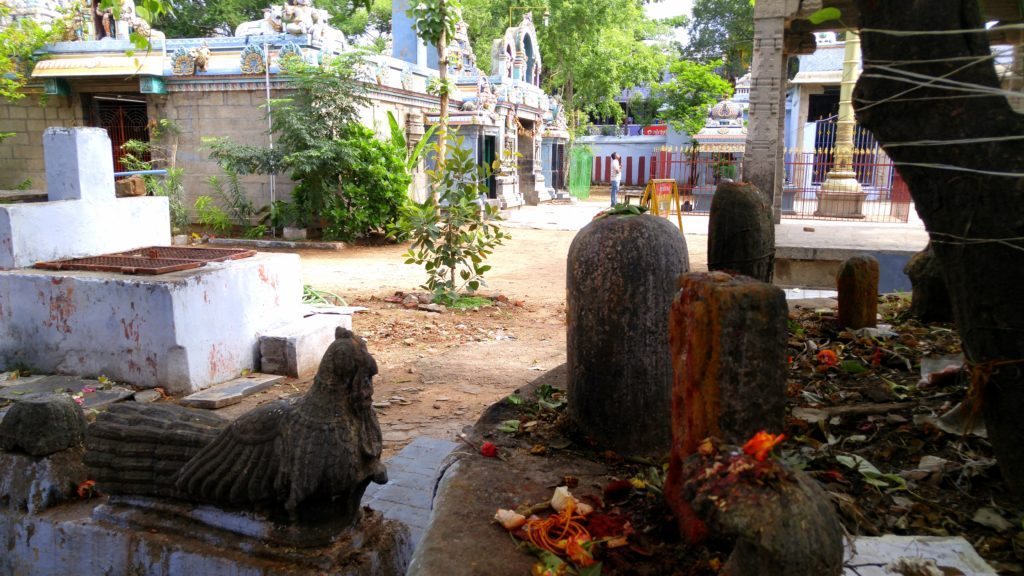
The deities in the company temple
These temples may not have the architectural splendour of an ancient Chola or a Pallava temple but they were built by the British primarily to lure the weavers to live in this hamlet. Almost 200 families had settled here at one time.
Zion Church and the Goschen Library
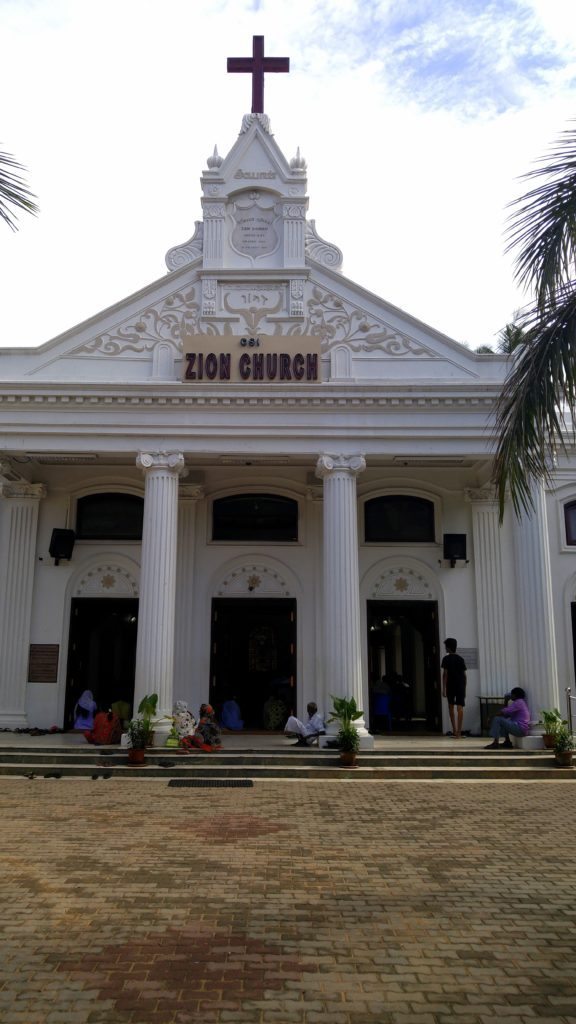
Zion Church in Chennai
Started by the Americans in the 19th century, the Zion Church has always fascinated me. It is now part of the CSI. Opposite the church is one of the oldest libraries – the Goschen Library which is now the Madras District Branch Library. What I really found fascinating in this 200 year old Reading Hall is this floor drawing at the entrance. Chintadripet is known for its schools, although some buildings looked like they might collapse anytime.
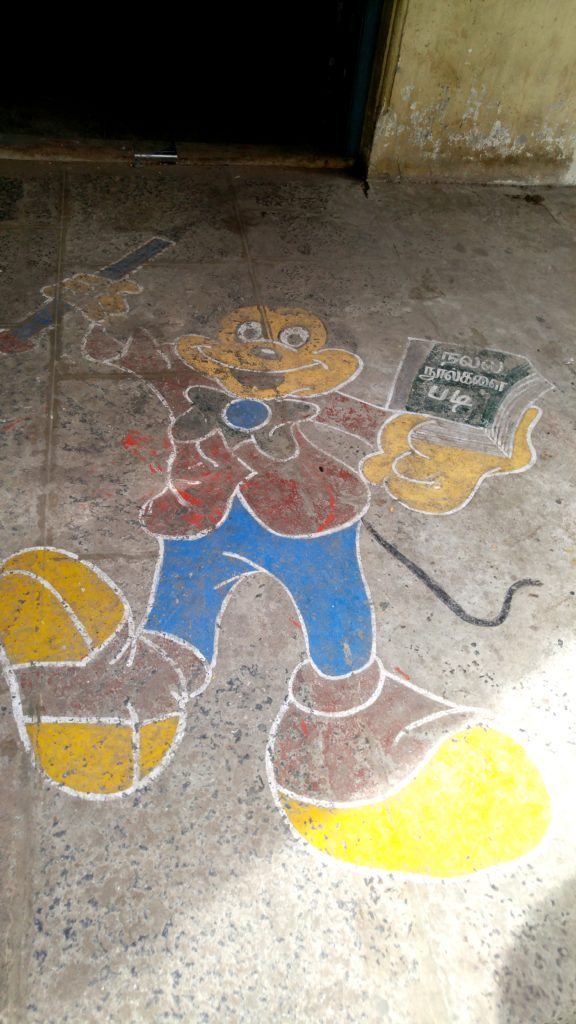
The floor drawing in front of an old reading room
Pudhupet
Probably an area created to differentiate from Chintradripet, Pudhupet or the “new” settement is on the adjacent bank of the Cooum. Venkatesh added that this area had some of the more affluent members settling down, including Pachaiappa Mudaliar, one of the patrons of the city and a dubash as well. We stopped at two temples, one of them probably lending the name to the river.
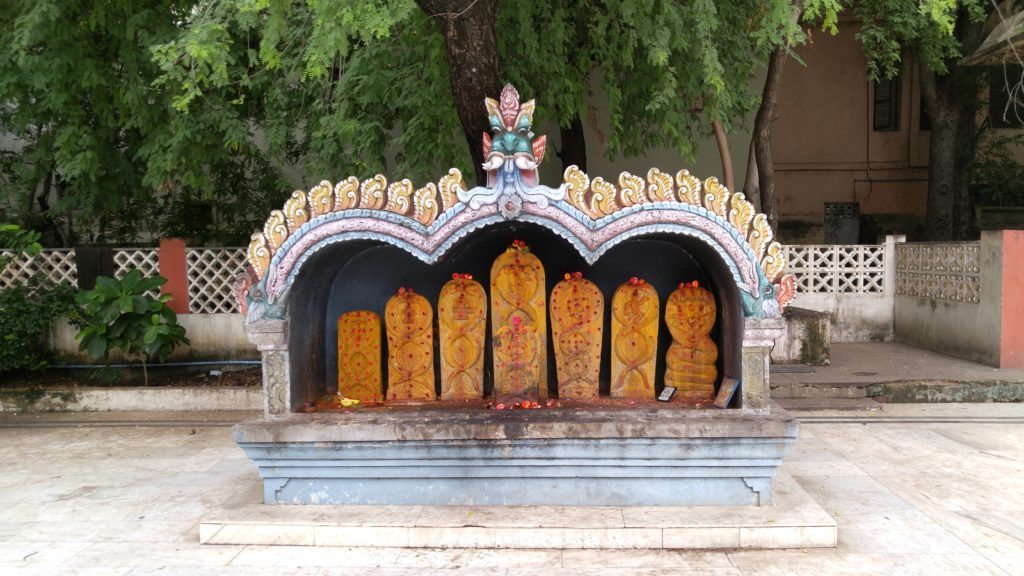
The temples of Pudupet
Ranganatha Swamy Temple and the Komaleeshwaram Swamy Temple
We headed to the old Ranganatha Swamy temple hidden in the lanes of Pudhupet built by one of the Dubash, but not on the Company money. The silence was simply overwhelming . We finally went to Komaleeshwaran temple, one of the oldest believed to have given the name to Cooum. However this seems to be just a theory. But records however said that coracles floated on the river, then clean bringing flowers to the temple for festivals.
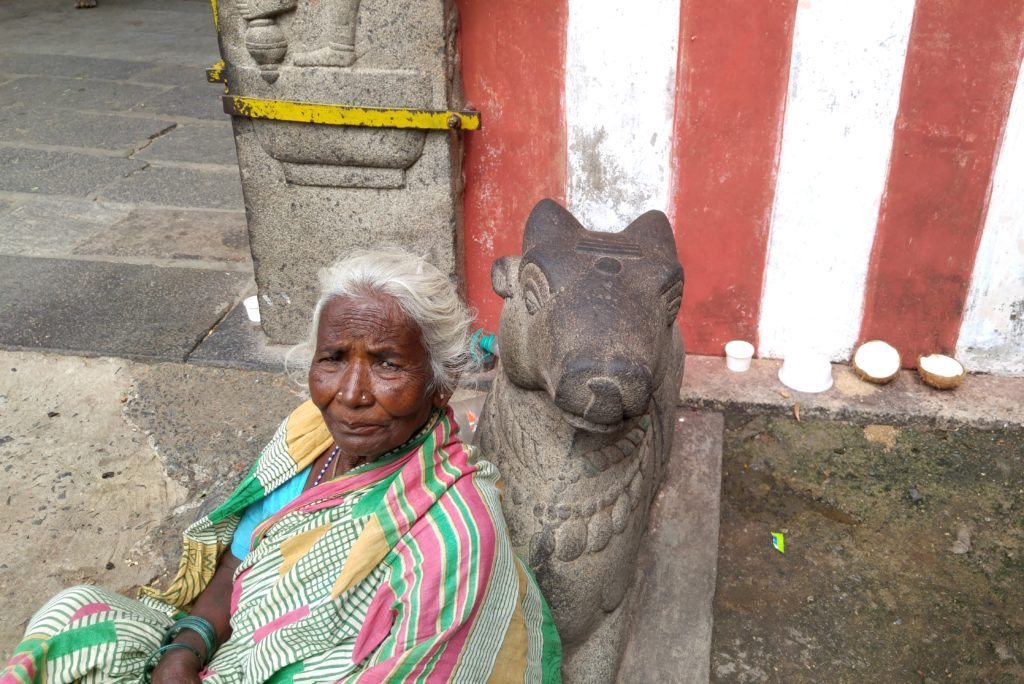
People outside who have merged with these temples
Story of a vaccinator
Our last stop was at Pagoda Street or Harris Street as it was called later and Aditanar Road today where we went to see a statue on a little pillar. Shrouded by leaves and standing behind a fence is the man who was known as WS Swamy Naick, a vaccinator. It was the early 19th century and vaccination had just begun. It was not a practice as we know it today and he found himself surrounded by hostile men who suspected him of witchcraft and was eventually beaten up by a group of Armenian merchants, said Venketesh. However the medical man persisted continuing his work as a mission.
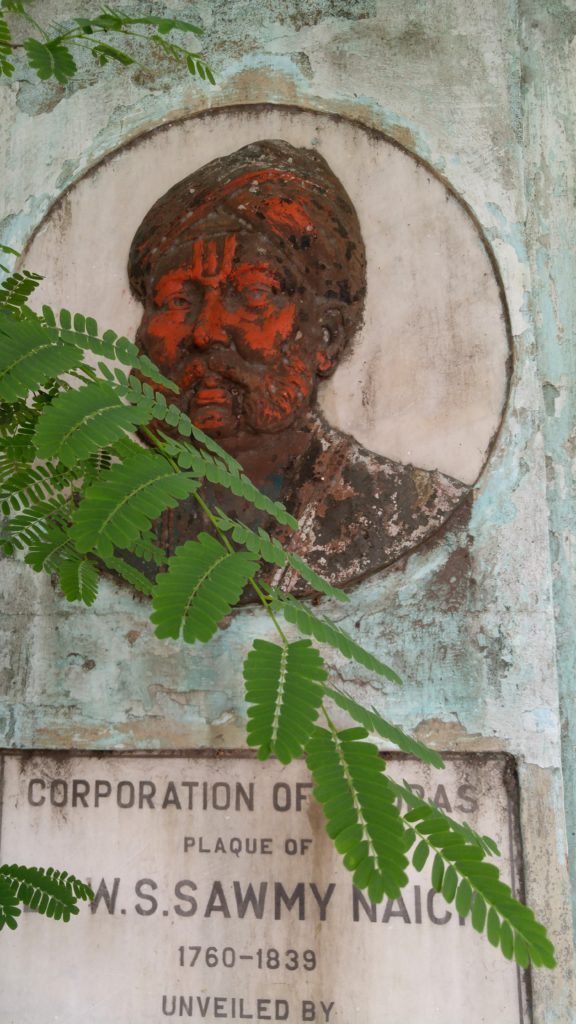
Story of a vaccinator
Our trail finally ends here. Thanks to Venketash Ramakrishnan for taking the time out to narrate the stories and a special thanks to Sriram V whose articles, shared by Venketesh have helped me with a bit of research as well.
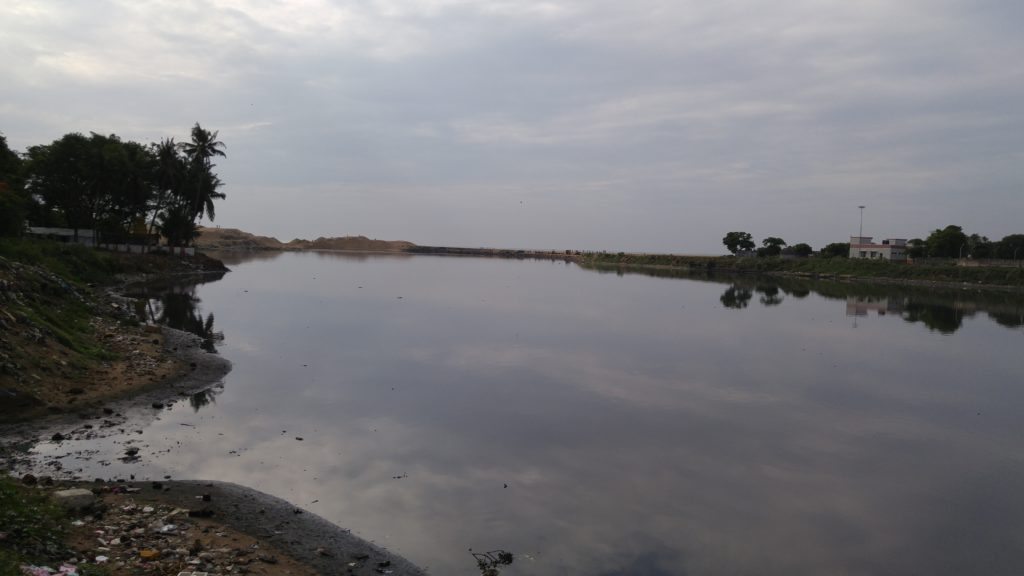
Still waters run deep..in history
R Venketesh is a novelist whose latest book “Gods, kings and slaves” is about Malik Kafur and his invasion of South India. The book is available in all stores as paperback version and as an ebook as well online.
The post On the Cooum trail in Chennai appeared first on Lakshmi Sharath.















































